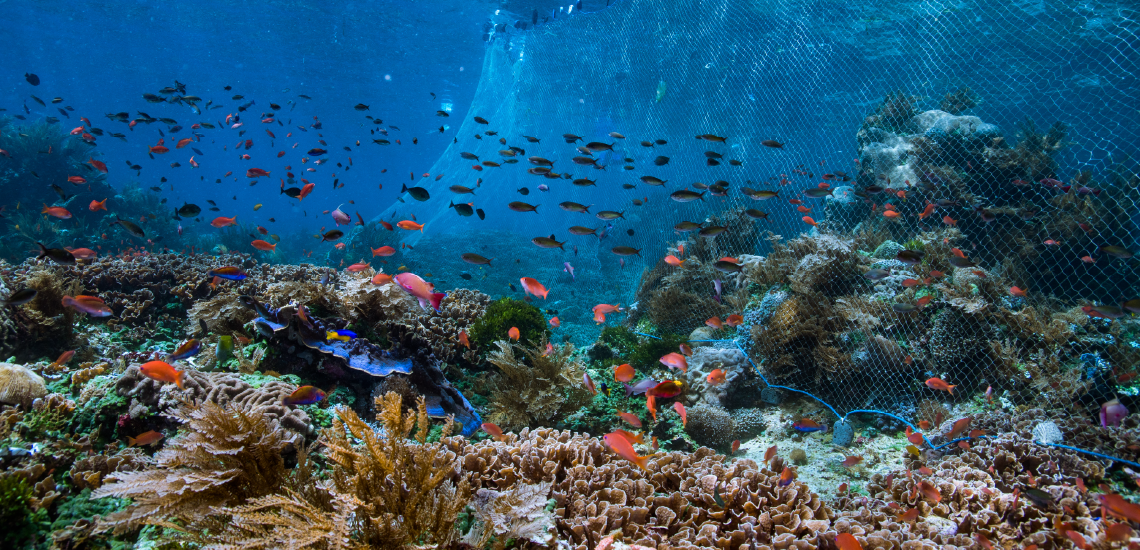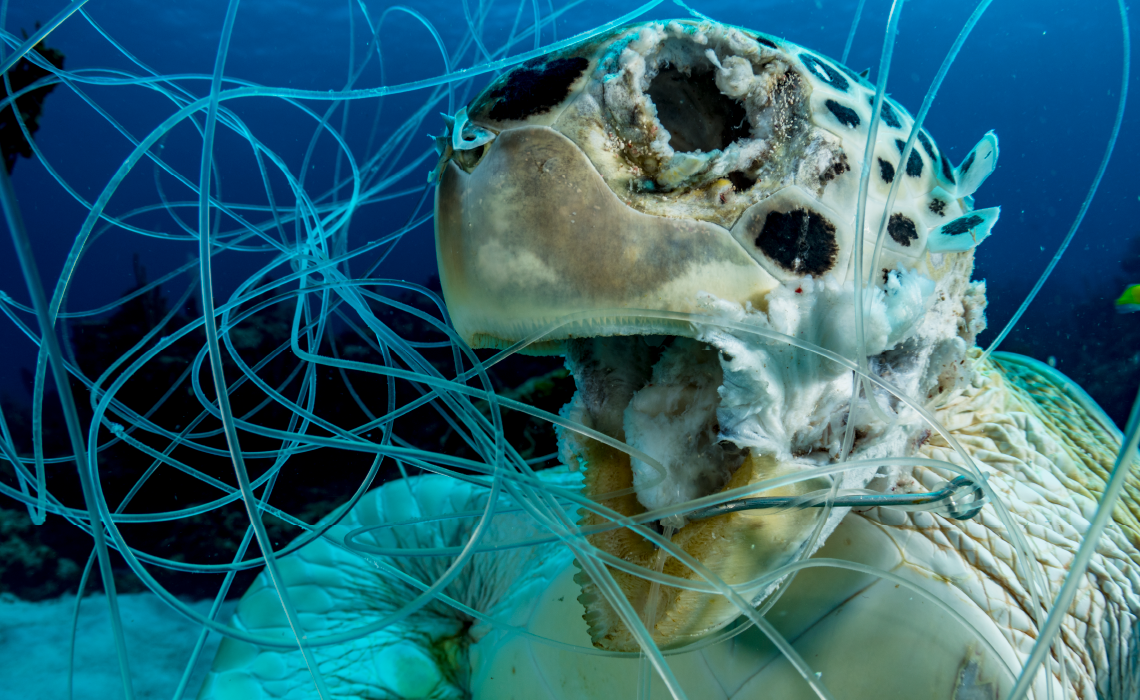
As part of the annual World Oceans Day celebrations, the Our Beautiful Ocean exhibit highlights the beauty of the ocean, some of the challenges it faces, in particular from plastic waste, and how humans are helping to overcome this.

This beautiful image is of the European fan worm. The fan worm extends a fan-like crown of tentacles through the opening of its tube. These tentacles filter the water for food. When the worm is disturbed it withdraws into the tube and closes the end off. [Photo/Domenico Tripodi]
2018 World Oceans Day – Underwater Seascapes Category Winner
Beauty and the Beast
Some of the most beautiful species in our oceans, such as the colorful lionfish, or the European fan worms in the image above, have also become invasive species after being introduced into new ecosystems, usually by humans, where they compete with native species.
Invasive species constitute a global-scale problem affecting health, agricultural potential, and biodiversity.
The Convention on Biological Diversity recently issued guidelines to stop the escape of alien species, including from aquariums, to prevent damage to local ecosystems.
You can help, by making sure any fish you use in an aquarium has been shown to be non-invasive.

Stand up paddle boarders in Ha'apai, Tonga exploring the shallow reefs at sunset. The photographer wanted to demonstrate the innate bond humans have with the ocean, whether they are physically in it or floating on the surface. Our inherent relationship with the ocean is eternal and we must care for it in a way that ensures sustainability for the future. [Photo/Grant Thomas]
2018 World Oceans Day Photo Competition – Human Interaction Category Winner
Beauty and Diversity
Coral reefs make major contributions to life in many countries, especially Small Island Developing States (SIDS), like the Pacific island of Tonga where the image above was taken.
In these countries coral reefs are important in the provision of food, materials and income from tourism and fisheries.
Coastal and island societies are often largely or nearly completely dependent on adjacent coral reefs, with cultures developed around those reefs; and reefs contain the largest reservoirs of biodiversity in the world.
Many Pacific communities have developed strong cultural affinities towards the reefs and many of these remain active and recognized by local and national governments.
The image below shows the island of Mayotte, which has the largest barrier-reef-lagoon complex in the southwestern Indian Ocean.* The complex is home to an incredible diversity of marine species.
*(Zinke, J., Reijmer, J. J. G., Thomassin, B. A., Dullo, W. Chr. (2003) Postglacial flooding history of Mayotte Lagoon (Comoro Archipelago, southwest Indian Ocean). Marine Geology, 194, 181-196)

Aerial view from Handrema point in Mayotte, an island in the Indian Ocean off East Africa between Madagascar and Mozambique. [Photo/Gabrial Barathieu]
2018 World Oceans Day Photo Competition - Above Water Seascapes Category Winner
Committed Mother
The importance of gender equality, in particular for the effective conservation and sustainable use of oceans, seas and marine resources is increasingly being recognized. A concerted action towards gender equality and the empowerment of women and girls is needed in all ocean-related sectors to achieve Sustainable Development Goal 5.
In the image below a female octopus vulgaris (common octopus) sits with her eggs. Females rarely leave their eggs and usually do not feed during the entire period of spawning and brooding, which can be as long as 4-5 months. Egg care includes cleaning the eggs with the arm tips and directing jets of water from the funnel through the strings. As a rule, females die shortly after the hatching of the last embryos after losing one-third of their pre-spawning weight.*
*University of Michigan Museum of Zoology

Female octopus guarding recently laid eggs. During this period, the female doesn't feed itself and starts weakening until the hatching of its last egg, when it usually dies. [Photo/Marc Casanovas]
2018 World Oceans Day Photo Competition - Underwater Life Category Winner
Marine Debris – a Silent Killer
Marine debris is present in all marine habitats, from densely populated regions to remote points far from human activities, from beaches and shallow waters to the deep-ocean trenches. The amount of debris in the marine environment is a cause for concern. It is known to be harmful to marine life, it presents a hazard to shipping (propeller fouling), it is aesthetically detrimental, and it may also have the potential to transport contaminants over long distances.
Marine debris, and in particular the accumulation of plastic debris, has been identified as a global problem alongside other contemporary key issues, such as climate change, ocean acidification and loss of biodiversity. Marine animals become entangled in debris, and even mistake it for food – often killing them. In the image below an endangered green turtle has been hooked and left to die in an abandoned fishing line.

In this image an endangered green sea turtle is hooked and left in fishing line in Eleuthera, Bahamas in August of 2017. Green turtles are unique among sea turtles in that they are herbivores, eating mostly seagrasses and algae. This diet is what gives their cartilage and fat a greenish color (not their shells), which is where their name comes from. [Photo/Shane Gross]
2018 World Oceans Day Photo Competition – Clean our Ocean Category Winner
Everyone needs to do their part
Humans can also be the solution to problems like marine debris. In the image below, young divers in Manly Cove, Sydney, Australia take part in a local ocean cleanup to promote Project AWARE’s 'Dive Against Debris’ program.
The program empowers scuba divers to remove marine debris from their local beaches and oceans and report data on the types, quantities and locations of materials collected. Since the program’s launch in 2011, more than 50,000 divers have participated in Dive Against Debris in 114 countries around the world, reporting over 1 million pieces of trash.
"Everyone needs to play a part. You can make a difference today – and every day -- by doing simple things like carrying your own water bottle, coffee cup and shopping bags, recycling the plastic you buy, avoiding products that contain microplastics and volunteering for a local clean-up."
— António Guterres, Secretary-General of the United Nations, World Oceans Day message 2018

The beautiful waters of Manly Cove, in Sydney, Australia have been tainted by plastic pollution from the surrounding bars, fast food outlets and restaurants. However, in this image young divers with Dive Centre Manly show how individuals can help protect our ocean by taking action at the local level. The dive center runs 'Dive Against Debris' events every couple of months bringing together 80- 100 concerned citizens to help with the clean up. [Photo/Rosie Leaney]
2018 World Oceans Day Photo Competition – Theme Winner
Photographers
Domenico Tripodi is an Italian photographer based in Reggio Calabria.
Grant Thomas is a Scottish award-winning international photographer who dedicates his life to capturing mother natures’ finest moments. In 2018 he was named British Underwater Photographer of the Year.
Gabriel Barathieu spent his childhood alongside the Atlantic ocean in the Landes, southwestern France. He has published in various specialized underwater photography publications and pursues professional photography alongside a passion for scuba diving.
Marc Casanovas is a Spanish diver and award-winning underwater photographer. Among his many awards is GDT European wildlife photographer of the year. He also teaches underwater photography.
Shane Gross is a marine conservation photojournalist, using images of the underwater world to benefit the ocean. He is currently based in The Bahamas, telling stories about the sharks, turtles, fish, whales and other creatures and habitats that call the sea home.
Rosie Leaney is a youth photographer based Manly Cove, Sydney, Australia.
This exhibit was launched in June 2019
